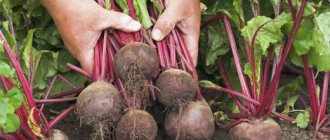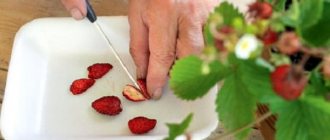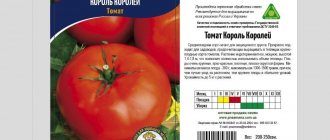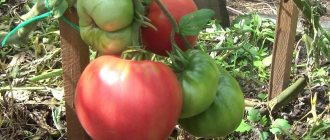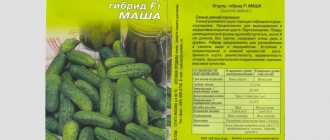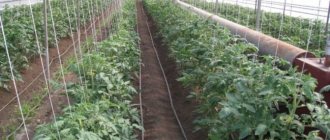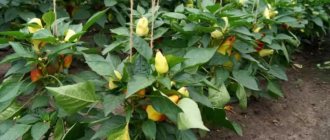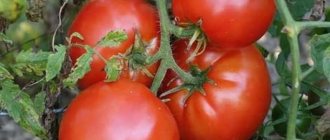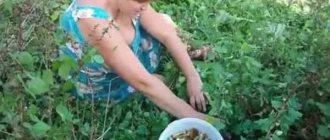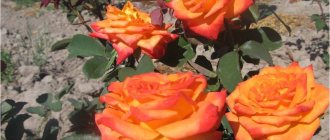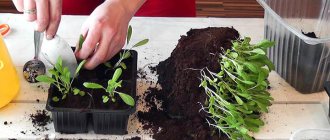Sugar beet varieties and hybrids differ in many respects. But among them there are absolute leaders, bred as a result of many years of selection. Now you will learn about the nine best varieties of beets based on a combination of characteristics.
Table beets should, first of all, be tasty, safe for health and have a long shelf life. Many gardeners believe that the entire set of these qualities can only be found in varieties of foreign selection. And it’s true – imported root crops are smooth and beautiful, consistently delivering high yields. But among domestic varieties you can also find sweet and spicy varieties. We will tell you about the best of the best representatives of the beet world.
Bravo
The table variety “Bravo” was bred at the West Siberian vegetable base and approved for use in 1997. It is considered a very productive, unpretentious and tasty variety.
It can be grown from Moldova to the Ural Mountains.
The characteristics of this variety are as follows:
- fruit shape – round;
- fruit color is dark red, leaf color is dark green;
- weight – 200-780 g;
- the pulp is dark red, tender and juicy, there are no rings;
- taste – sweet;
- average ripening period - from 70 to 100 days;
- yield – 6.6-9.0 kg/sq. m;
- suitable soil type - loam, clay;
- has high keeping quality;
- sugar content – 15.8-17.9%;
- affected by cercospora blight, damaged by beet midge.
Single shoot
This table variety was bred in 1976 at the All-Russian Research Institute for Selection and Seed Production of Vegetable Crops. Used in the Northern, Northwestern, Central, Central Black Earth and Middle Volga regions.
Variety characteristics:
- the shape of the root crop is round and round-flat;
- color – dark purple, smooth surface;
- pulp – dark burgundy, juicy, tender;
- weight – 297-314 g;
- considered an early ripening variety, but can ripen from 80 to 130 days;
- yield – 4.0 kg/sq. m;
- soil – loam, clay;
- Suitable for long-term storage.
Bordeaux 237
The variety, discovered in 1943, is approved for use throughout the Russian Federation. This is one of the most popular and studied varieties. It is considered heat-loving, but is drought-resistant.
Variety characteristics:
- fruit shape – round with a small head;
- petiole – bright pink, length – 20-31 cm;
- surface – rough;
- weight – 232-513 g;
- pulp – intensely dark red;
- characterized by good keeping quality;
- relatively resistant to diseases, can be affected by cercospora and peronospora;
- refers to early varieties - the fruit is formed in 85-95 days;
- yield – 3.5-8.0 kg/sq. m;
- soil – loam, clay.
Is there only sweetness in this beetroot?
Of all types of beets, sugar beets are the sweetest. The sugar content in its modern varieties is more than 20%. It was bred from fodder beets just for the industrial production of sugar in the 18th century in Germany. And this was done due to the fact that vegetables generally contain quite a lot of sugar: in the dining room - 8.3%, in the feed - 6%.
Mona
A variety that was created jointly by breeders of Semco Junior CJSC and a Czech company. Used throughout the Russian Federation since 1991.
Variety characteristics:
- fruit shape – cylindrical;
- color – red, leaf color – green-red;
- weight – 200-330 g;
- the pulp is dark red, tender, juicy, the rings are slightly pronounced;
- yield from 5 to 6 kg/sq. m;
- has good keeping quality;
- full ripening period – 75-100 days;
- the taste is good.
Used for storage, canning and growing into bunched products.
Is it possible to increase the sweetness of root vegetables?
You can increase the sweetness of beets if you take proper care of them:
- Use the best purchased seeds.
- Prepare loose, slightly alkaline soil with a pH of 6.5-7.5, fertilized with ash and humus.
- Systematically water, loosen, and mulch.
- Feed the plants with ash and mullein solution, but not with manure.
- Once a season, water the soil with a solution of boric acid at the rate of 10 g per bucket of water, at the beginning and end of June - with nettle infusion.
- Harvest small 5-6 centimeter root vegetables.
IMPORTANT! The sweetness of beets can be increased with table salt (non-iodized). You should dilute one tablespoon per 10 liters of water and water the garden bed with this solution three times. When six leaves grow, the fruit will grow 4 cm out of the ground, after that in half a month.
Sweet varieties of table beets, like sugar beets, have a large amount of useful substances and play an important food role both in everyday life and in the food industry. Therefore, of fundamental importance for obtaining a high-quality harvest of sweet beets is the choice of varieties adapted to Russian weather conditions, which grow better, bear fruit abundantly, and have an excellent taste.
Information on which varieties are suitable for cultivation in open ground in the Russian Federation, including in the middle zone and the Urals, can be obtained on the pages of our website. Among them you will find many varieties of sugar, table and fodder beets. The only exception is the leafy form of this wonderful vegetable - the Russian climate is unfavorable for it.
Valentina
This variety was bred in 1999 for use in the North-West region. This variety is valued by gardeners for its high degree of single-seeding and cold resistance.
Variety characteristics:
- leaf shape – triangular, color – dark green with red veins;
- the shape of the root crops is leveled;
- fruit color – dark red;
- weight – 170-333 g;
- the pulp is dark red, with faint rings;
- ripening time is average;
- yield - 2.8-4.4 kg/sq. m;
- has good keeping quality;
- soil – loam, clay.
Useful properties of sugar beets
The plant has many beneficial qualities. It helps heal the liver, heart, and cleanses the blood. The fruits are enriched with vitamins A, C, B. In addition, they contain manganese, zinc, iron, manganese, and copper.
This vegetable can be consumed for:
- Memory improvements;
- Reducing cholesterol;
- Cancer prevention;
- Increasing the amount of iron in the body.
Drinking beetroot juice daily refreshes the skin. The price of this elixir is affordable for everyone. The root vegetable helped some girls become slim.
Cylinder
The cylinder is an achievement of breeders twenty years ago. The variety can be grown in all regions of the country.
Variety characteristics:
- fruit shape – elongated, cylindrical;
- diameter – 4-7 cm, length – 12-16 cm;
- mid-season variety – 120-130 days;
- pulp – dark red, without rings;
- fruit weight - from 250 to 600 g;
- yield – 7-10 kg/sq. m;
- leaves are medium sized, light green;
- has good keeping quality;
- weakly susceptible to disease;
- taste – sweet;
- sensitive to low temperatures;
- soils – loams, clay;
- Suitable for canning and processing.
Dark varieties without light rings
The health benefits of beets depend on the intensity of their color. The rich, deep burgundy or dark purple color is due to the presence of high concentrations of anthocyanins. These substances are natural antioxidants. Their ability to strengthen the walls of blood vessels and the presence of antiseptic properties have also been scientifically proven. Accordingly, varieties and hybrids are especially valued, the pulp of which does not have pinkish or whitish rings.
Single shoot
The variety was bred in the USSR. Recommended for cultivation in the European part of Russia, including the northern regions.
Single-sprout beetroot requires picking and thinning of seedlings much less than other varieties
The variety is considered early ripening, but the period of ripening of root crops can be 80 or 130 days. It depends on the climate in the area. A characteristic feature of Odnosprostkova is its one- or two-seeded fruits. Other beet varieties most often produce 4–6 shoots from each seed. Because of this, you then have to carry out picking or thinning, which the culture does not like very much.
Root vegetables are round or slightly flattened. Weight varies from 300 g to 600 g. The taste is good, but not outstanding. The variety is suitable for long-term storage.
Egyptian flat
A variety that has been tested by more than one generation of gardeners and still withstands competition from new breeding products. Gives consistently high yields in the Urals, Eastern Siberia, and the Far East.
According to the ripening period, it belongs to the medium-late category. The harvest ripens in 94–120 days. The variety is valued for its excellent keeping quality. If you create optimal or close to them storage conditions for root crops, 88–90% of the harvest will last until March of next year without losing its presentability, juiciness and taste.
Egyptian flat beet stands out for its very good keeping quality
The root crops are noticeably flattened (this is reflected in the name), varying in size (300–500 g). By the way, this form is often considered an advantage by gardeners - root vegetables are convenient to cut, they can be more compactly folded into a pan when cooking and into storage boxes. The pulp is quite juicy and pleasant to the taste: sweetish, of uniform consistency. The yield is not bad, but not record-breaking (5–8 kg/m²).
Among the undoubted advantages of the variety is drought resistance. Poor (50%) seed germination is often noted as a disadvantage. But this largely depends on the manufacturer.
Boltardi
Dutch beet variety. The state register recognizes this variety as suitable for cultivation in the Central region. But growing experience shows that it produces a good harvest throughout the European part of Russia. The variety is early, but nevertheless excellent for long-term storage.
Boltardi is an early beet, but it stores very well
Vegetables are almost regular spherical in shape, not particularly large (160–370 g). The variety is valued by gardeners for its stable fruiting, little dependent on the vagaries of the weather, and the presentability and one-dimensionality of its root crops. An undoubted advantage is the presence of “innate” immunity to color. As a disadvantage, the yield is not very high, due to the size of the beets (2.7–3.1 kg/m²).
Libero
Another beet variety from the Netherlands. The state register recommends it for cultivation in the Central region, not only for amateur gardeners, but also for professional farmers.
Libero beets are in demand not only among amateur gardeners, but also among professional farmers.
A variety from the mid-early category. The root vegetable is a very dark scarlet color, the characteristic “plug” at the base is practically absent, the skin is smooth. The average weight of one beet is 125–225 g. The Libero variety rarely suffers from bolting.
Among the undoubted advantages of this variety are the massive ripening of root crops, their presentability and good taste. You can also note the keeping quality and high yield.
Bohemia
A relatively recent achievement of Russian breeders. The variety has excellent taste. The Volga-Vyatka region was considered the most suitable region for its cultivation.
Bohemia beets are primarily valued for their excellent taste, but are not without other advantages.
Bohemia is a mid-season beet. The root crop is flattened, with pronounced suberization at the base. The flesh is dark burgundy. One beet weighs 210–350 g. The variety has good immunity to all fungal diseases typical for the crop, and is stored well without losing its taste or visual appeal.
Bordeaux 237
An “old, well-deserved” variety whose competitiveness has been tested by time. It is still one of the most popular.
A variety from the early category, root crops are formed in just 85–95 days. Moreover, this period depends little on what the weather is like. Vegetables are round. Weight varies from 250 g to 500 g. They reach approximately 15 cm in diameter. Root crops stick out about half of the soil, this is normal.
Beet Bordeaux 237 has not lost its popularity for more than 70 years
The advantages of Bordeaux 237 beets include a very good taste that is not lost during storage, and good keeping quality. The short period of ripening of root crops allows it to be planted several times with an interval of 8–15 days, thereby prolonging the fruiting period. The variety tolerates both heat and coolness well and is little susceptible to temperature changes. Productivity is 7–8 kg/m².
Video: what Bordeaux beets look like
Detroit
Despite the name, this beet originates from Italy. The state register recommends for cultivation in the Central region. But the experience of gardeners shows that this variety is very well suited for the Far East.
Detroit beets look very presentable
Detroit is characterized by average harvest ripening times. Approximately 110 days pass from the moment of germination. Root vegetables look very presentable - almost perfectly round, with a thin short root and smooth skin. The flesh is uniform, burgundy. The average weight of one beet is 110–215 g. Sugar content is 12.3–14.2%.
The variety is valued for its stable fruiting and attractive appearance of root crops. This beet is suitable for canning and long-term storage. Detroit is also characterized by good cold resistance, shelf life and immunity to flowering.
Video: Detroit beets
Lark
A Dutch variety popular all over the world. The Russian State Register has recognized it as suitable for cultivation in the Central region and the Urals. Larka is a mid-season beet, but it is suitable for long-term storage. The variety is also good for processing, which is why it is in demand not only by amateur gardeners, but also by farmers.
Larka beets are in demand not only in Russia, but throughout the world
Root vegetables are medium-sized (140–310 g), almost spherical, the flesh is rich scarlet. Suberization is weakly expressed. The percentage of non-commercial defects is extremely low - 6%.
Among the advantages of the variety are consistently high yields, one-dimensionality and external attractiveness of root crops, and good keeping quality. The larka is resistant to flowering, mechanized harvesting is possible. The originator states that the variety has an increased ability to remove heavy metal salts and half-life products of radioactive substances from the body.
Bona
The Russian State Cultivation Register has not established any restrictions regarding the region. Suitable for both fresh consumption and canning. Characteristic and very good keeping quality.
No obvious deficiencies were found in the Bona beet variety.
Beets are from the mid-season category. The root vegetables are almost spherical, with very juicy, tender, sweetish pulp (sugar content - 12%). Suberization is minor. They are one-dimensional (weight - 250-280 g), the taste is very good.
Productivity is average - 5.5–6.8 kg/m². The advantages of the variety are the presentation and uniformity of root crops, suitability for long-term storage.
Renova
A variety of mid-late beet. The crop ripens 100–110 days after germination. Renova is suitable for long-term storage; the fruits do not lose their presentation and benefits for 6–7 months.
Renova beets have almost no characteristic smell, which many people don’t like.
Root vegetables are cylindrical in shape, up to 5 cm in diameter. There is practically no characteristic aroma, which not everyone likes. The average weight of one beet is 180–350 g. The total yield is 7–9 kg/m².
Cylinder
An achievement of breeders twenty years ago. The variety is recognized as suitable for cultivation in all regions. Popular with both amateur gardeners and farmers.
Cylinder is a mid-ripening beet variety. Approximately 120 days pass from the emergence of seedlings to harvesting. Most suitable for canning and long-term storage.
Having just appeared, Cylinder beets almost immediately gained incredible popularity among domestic gardeners
Root vegetables, as the name suggests, are cylindrical in shape. The average diameter is 4–7 cm, length is 12–16 cm. Weight varies from 250 g to 600 g and depends on growing conditions. The taste is excellent. Other advantages are high yield (8–10 kg/m²), low percentage of root crops being rejected. The inherent shape of the beet variety makes it possible to compact the plantings. A significant drawback is sensitivity to low temperatures. If seedlings are subject to return spring frosts, mass flowering is very likely.
Video: description of beet variety Cylinder
Cardial F1
A recent achievement of French breeders. It is recommended to plant the hybrid in the European part of Russia.
Beetroot Cardial F1 is very good in any dish
Medium ripening hybrid. Root vegetables are close in shape to a ball. Suberization is moderate. Weight varies from 210 g to 350 g. Sugar content - 10.3–12.6%. The percentage of non-commercial products is 3–12%.
Kestrel F1
A French hybrid, recommended in Russia for cultivation in the Volga region, the Caucasus and the North-West region. Suitable for long-term storage. The harvest matures in approximately 120 days. The hybrid belongs to the mid-season category.
Kestrel F1 beets are tolerant of transplanting and diving
The roots are almost round, suberization at the base is moderate. One beet weighs 205–375 g. The sugar content is relatively low - 5.7–10%. The percentage of defects is within the norm - 4–16%. The undoubted advantage of the variety is the presence of high immunity. Beetroot rarely suffers from diseases typical for the crop. Also, unlike the vast majority of other varieties, it tolerates picking and replanting without much stress.
Oxblood
Another recent achievement of Russian breeders. The purpose is universal. This beet is also characterized by good keeping quality. A variety from the mid-season category.
Beetroot Ox's blood is a universal root vegetable
Root vegetables are round. Suberization at the base is moderate. The weight of one beet varies from 145 g to 240 g. The taste is wonderful. The sugar content is low - 8–10.5%.
The variety is valued for its consistently high yield, suitability for long-term storage, good frost resistance, and resistance to flowering. Root crops ripen in 110–120 days.
Video: review of beet varieties without light rings
Libero
This is a beet variety grown in the Netherlands. Recommended by the State Register for cultivation in the Central region since 1999.
Gardeners value this variety for its early production and relative resistance to bolting.
Libero characteristics:
- leaves are oval-shaped, green-red in color;
- leaf rosette erect;
- the shape of the root crops is leveled, round;
- weight – 125-225 g;
- head slightly suberized;
- belongs to the category of mid-early;
- The advantages include massive fruit ripening, presentable appearance and good taste;
- yield – 1.8-5.8 kg/sq. m;
- soils – loams, clay.
Feed varieties
Fodder beets are grown to provide livestock with food for the winter. Not only the vegetables themselves are eaten, but also the tops. The highest yields are for varieties with root crops in the shape of a cylinder, cone or bag. And the sweetest of them are pink, white and yellow.
The most popular are:
- Semi-sugar pink. Medium late variety. In the State Register since 1985. The roots are cone-shaped, the skin is white, turning pink closer to the base. The pulp is snow-white. The variety is valued for its keeping quality and very good immunity.
- Marshal. Danish late variety. Recommended by the State Register for cultivation in the Black Sea region, the Volga region, and the North Caucasus. The roots are cylindrical, pale green, the part protruding to the surface has a reddish tint. The average weight of beets is 765 g. It rarely suffers from rootworm, jaundice and mosaic viruses.
- Centaur Poly. Mid-late beets come from Poland. It has been listed in the Russian State Register for 20 years. It is recommended to cultivate it in the Black Sea region. The roots are oval, white, greenish on the surface. Of the diseases typical for the culture, it most often suffers from flowering, but is practically not susceptible to the rest.
- Eckendorf yellow. In the State Register since 1943. The roots are yellowish, grayish-green on the surface. They protrude almost two-thirds above the ground. The rosette of leaves is very powerful. Valued for its high cold resistance and shelf life.
- Hope. An achievement of Russian breeders almost 20 years ago. Recommended for cultivation in the European part of Russia and the Far East. The roots are elongated, dull red. The pulp is snow-white. Valued for its high yield. Prone to powdery mildew and cercospora.
Mulatto
This variety is not very different from all other table beets. The most suitable regions for cultivation are the Volga region, the Black Sea region, and the Far East. Widely used for cooking, suitable for long-term storage.
Characteristics:
- fruit shape – regular, round;
- 95-98% of commercial products are obtained;
- mid-late beets (125-130 days after seed germination);
- suberization is practically absent;
- weight – 160-360 g;
- little susceptible to temperature changes;
- pulp – dark burgundy, juicy, tender, without rings;
- yield – 2.5-4.4 kg/sq. m.
What does it depend on?
The sweetness of beets can vary greatly, as can their juiciness and softness. The sweetness of beets is characterized by the percentage of sugar it contains.
With incorrect cultivation techniques, you can get hard and unsweetened root vegetables.
Of fundamental importance is:
- selection of quality seeds;
- proper care - sufficient uniform watering, maintaining constant soil moisture and looseness, air access to the roots, thinning out seedlings, proper fertilizing and alkalization of the soil, maintaining a pH of 6.5-7.5, weeding, mulching;
- the size of the collected root crops should not exceed 5-6 cm.
Rocket F1
A mid-season hybrid from Holland that can be grown in the European part of Russia and Western Siberia. Gardeners value the variety for its resistance to flowering and drought. Rocket root vegetables are significantly different from other varieties, as they have an unusual shape.
Characteristics:
- fruit shape – cylindrical, large;
- fruit color is dark red, the surface is smooth, glossy;
- the color of the pulp is purple, there are no rings;
- suberization is weak;
- weight – 220 g;
- sugar level – 11.7%;
- yield – 5-7 kg/sq. m;
- high level of keeping quality;
- diameter of root crops – up to 5 cm;
- full ripening period is 120-125 days.
The best varieties of beets
The best table beet varieties are distinguished by their balanced taste. They are suitable for fresh consumption.
Rival
Medium ripening variety. Valued for its high yield and excellent taste. Small dark red root vegetables with a diameter of only 4–6 cm and a weight of 200–300 g. The pulp is very juicy and tender. The variety is demanding when it comes to watering. Productivity is average - 4.5–7 kg/m².
To obtain a bountiful harvest, Rival beets need to be properly watered.
Andromeda F1
Early variety. The state register recommends for cultivation in the Black Sea region. Single-germ hybrid. The root vegetables are cylindrical, up to 6.5 cm in diameter, very large - more than 680 g. The pulp is very juicy, cooks easily and quickly, and does not lose color during heat treatment. As a disadvantage of the variety, susceptibility to diseases is noted - root beetle, powdery mildew, cercospora blight, all types of rot. This variety is also sensitive to cold. A characteristic feature is the inability to accumulate nitrates.
Andromeda F1 beets cannot boast of good immunity
Kedry
A medium-ripening variety that very successfully combines the excellent taste of root crops with shelf life and high immunity. The root crops are cylindrical, reaching a mass of 320 g. Almost two-thirds of the beets stick out from the ground, this is normal. Productivity is approximately 7 kg/m².
The root crop of the Kedri beet sticks out of the ground by almost two-thirds
Opolski
Achievement of Polish breeders. Mid-season variety. In Russia, it is recommended for cultivation in the Black Sea region and the Central region. The roots are elongated, weight varies from 160 g to 440 g. They are half immersed in the soil. The variety does not suffer from Phoma blight, but can become infected with Cercospora blight. Productivity - 2.5–5 kg/m².
The greatest danger to Opolski beets is cercospora blight.
Black woman
Recommended regions for cultivation are the Volga region and the Far East. Medium ripening variety. Root vegetables are spherical, suberization is weak. Sugar content is 9.7%, but this does not affect the excellent taste.
Negro beets are not particularly sweet, but this does not affect the taste
Red ball
Red ball is classified as an early ripening variety. The growing season is up to 105 days. The variety is cold-resistant and suitable for cultivation for summer and autumn harvest.
Characteristics:
- fruit shape – round;
- fruit color – dark scarlet;
- the surface of the fruit is leveled, smooth;
- weight – up to 300 g;
- diameter – 3-3.5 cm;
- the pulp is dark red, juicy and sweet, without rings;
- Color-resistant.
This variety can be stored until April next year, and is also a storehouse of vitamins and mineral salts.
Choosing beets for greenhouse cultivation
The vegetable is suitable for growing indoors. In a greenhouse, seeds can be sown from the second decade of December, then already in early spring you can enjoy young root vegetables. Beet tops are also popular in cooking. Salads and light soups are prepared from it. You can harvest beets in a greenhouse when the vegetables reach 3 centimeters in diameter. By periodically thinning the plantings, the gardener allows the remaining root crops to grow to large sizes.
Suitable for indoor ground: Pablo F1, Cylinder, Detroit, Red Ball. For small (dessert) beets, the seeds are planted at a distance of 8 centimeters from each other; if you plan to grow larger root crops, it is increased to 10-12 centimeters.
See also
When to remove beets from the garden for storage, how many days does it take to grow? Read
Bohemia
This variety appeared recently, thanks to the work of Russian breeders. It has excellent taste, and the main region for cultivation is Volga-Vyatka.
Characteristics:
- shape – flattened, with obvious suberization at the base;
- fruit color – dark burgundy;
- weight – 210-350 g;
- the pulp is dark burgundy, there are no rings;
- quite resistant to fungal diseases;
- has good shelf life without losing taste and attractive appearance;
- mid-season variety - about 70-80 days pass from germination to ripening;
- yield – up to 4.8 kg/sq. m.
Beet varieties with high sugar content. The sweetest
The taste of beets depends on the sugar content in it. Lovers of a rich sweet taste should plant table varieties with delicate flesh and a pleasant aroma.
Detroit
A variety bred by Italian breeders in 1994. Its ripening period ranges from 80 to 100 days. An important advantage of Detroit is its high productivity. Compared to Bordeaux, Detroit produces 10-88 c/ha more. The crop can be grown in arid and relatively cold regions of the country with frequent spring frosts.
Detroit's flesh is dark red with a burgundy tint. It is distinguished by its juiciness and sweetish taste. The characteristics of the root vegetable allow it to be used for making juices and vitamin salads. Detroit is suitable for canning and long-term fresh storage.
The Detroit variety has several varieties. The sweetest is Dark red. The most frost-resistant variety is 6 Rubidus. It grows even in the absence of light and heat for a long time. If you have to store beets for a long time, it is better to choose variety 2 Nero.
Bohemia
Mid-season variety, reaching full ripening in 80-110 days. Refers to high-yielding varieties. One root crop can reach a weight of 0.5 kg with an average weight of 0.3 kg. The volume of the harvest directly depends on the fertility of the land, since this variety requires well-fertilized soil with a neutral pH.
Bohemia has no rings. Its pulp is homogeneous and juicy; color - dark burgundy.
The bottom of the advantages of Bohemia is the preservation of taste and appearance during long-term winter storage.
Bona
This variety is the result of the work of Czech breeders. The root vegetables are round, small, weighing 250-280 g. Bona pulp is red, juicy, with a sweetish taste (sugar content up to 12%). The variety is classified as mid-season. Ripening period is 80-100 days. Seeds are sown in April - early May, and harvest time is August-September.
If stored in a cool, dry place, Bona will last until spring.
Lark
Dutch beet variety of mid-early ripening. Larka is valued for its endurance. Thanks to its spreading tops and powerful root system, it tolerates long-term lack of watering. Drought does not affect the taste of the root crop. The beets are small in size (about 250 g), regularly round in shape, and have rich burgundy flesh without rings.
Bordeaux
Mid-early variety of root crop. Reaches technical ripeness at 60-115 days. In fertile soil, Bordeaux reaches 500 g, but overgrowth can be avoided by thickening the crops. In this case, the average size of beets will be about 250 g. The culture is hardy and grows even in arid regions and cold Siberia. Due to its short ripening period, Bordeaux is planted twice per season to obtain 2 harvests.
The flesh of Bordeaux is colored a rich dark red, the rings are barely noticeable.
The advantage of Bordeaux is the possibility of long-term storage and excellent taste.
Mulatto
One of the relatively “new” varieties registered in the Register of Breeding Developments of the Russian Federation in 2003. Its peculiarity is juicy, sugary pulp, in which the sugar content reaches 14.6%. Root vegetables are round in shape, slightly wavy. The pulp is juicy burgundy, with a purple tint. The rings are barely visible, there are no pronounced whitish circles, the root crop is small in size and weighs only 100-360 g. The peel is tender and thin, suberization at the base of the tops is rarely observed.
Mulatto's keeping quality is excellent, even if stored in suboptimal conditions. When growing a variety, it is worth taking into account its light-loving nature and intolerance to weeds.
Incomparable A463
This variety was bred in 1943 at the All-Russian Research Institute for Selection and Seed Production of Vegetable Crops. Used in the Central and Ural regions.
Characteristics of the Incomparable A463:
- fruit shape – flat and round-flat;
- the color of the fruit is dark red, the head is grayish, the color of the leaves is green and dark green;
- weight – 167-385 g;
- the petiole is elongated, with light veins, the color is intense red;
- the pulp is dark red, with blackish rings;
- early ripening variety - the growing season is 69-99 days;
- yield – 3.0-7.0 kg/sq. m;
- soil type – loam, open ground;
- disease resistance – average;
- The taste of the fruit is sweet.
Opolski
This is a table variety, bred in Poland in 1998. It can be used in the Central and Central Black Earth regions. It is recommended to plant in garden plots and farms.
Characteristics of the Opolski variety:
- rosette of leaves erect;
- leaf shape is oval, color is light green with strong anticyanin coloring of the veins;
- fruit shape – leveled, cylindrical;
- fruit color – dark red;
- weight – 158-438 g;
- the fetal head is small, convex, moderately corky;
- the pulp is dark red, tender, juicy, there are faint rings;
- yield in the Central region is 2.5-5.2 kg/sq.m. m, in Chernozemny - 3.1-5.3 kg/sq. m;
- has a high level of keeping quality;
- resistant to Phoma and moderately susceptible to Cercospora;
- soil – loam, clay.
The benefits of the magic root vegetable
Table beet
is a well-known vegetable; it is a frequent guest on any table. A seemingly simple root vegetable hides an entire periodic table. Beetroot has a unique composition of useful substances that do not lose their properties during heat treatment. The vegetable contains a number of amino acids necessary for the body, vitamins, microelements, organic acids, minerals and a huge amount of fiber.
Due to its beneficial composition, beets are used in folk medicine. It is used to treat runny nose, hypertension, constipation, tuberculosis, skin ulcers, and scurvy. The vegetable is consumed to strengthen the immune system, improve metabolism and remove toxins from the body.
Pronto
The variety was selected by the Dutch company Bejo Zaden. It can be used throughout the Northern region since 1995.
Gardeners value Pronto for its resistance to flowering.
Variety characteristics:
- leaf shape – elongated oval or oval, color – dark green;
- the shape of the root crops is leveled, round, color – red;
- weight – 110-152 g;
- refers to varieties of medium ripening;
- yield – 1.2-1.8 kg/sq. m;
- is resistant to diseases.
The importance of making the right choice
When choosing a variety, many gardeners are based on only one factor - high yield. This approach is fundamentally wrong, since even the most productive variety requires certain soil parameters, light and irrigation regimes.
The correct choice of variety should be based on many parameters:
- shelf life;
- taste qualities;
- ripening time;
- drought resistance;
- use of root vegetables;
- productivity.
When choosing a variety, it is better to use special zoned varieties that are adapted to given weather and climatic conditions.
Podzimnyaya A474
A variety obtained at the All-Russian Research Institute for Selection and Seed Production of Vegetable Crops. Approved for use in the North-Western, Central, Middle Volga, Volga-Vyatka and Central Black Earth Regions. Recommends growing it in early spring and winter sowings.
Characteristics:
- leaf shape – heart-shaped, elongated, color – green, becomes pigmented by autumn;
- petiole intensely pink-red, length – 25-35 cm;
- fruit shape – round;
- weight – 369 g;
- mid-early variety – 98-100 days;
- the pulp is dark burgundy, with an excellent, pronounced taste;
- yield – 4.3-6.1 kg/sq. m;
- relatively resistant to cercospora.
Detroit
It is an Italian variety. It is recommended to cultivate the variety in the Central region, but the experience of gardeners suggests that Detroit grows well in the Far East. The variety is valued for its cold resistance and resistance to flowering.
Characteristics:
- fruit shape – round, even;
- color – red, with a thin, very short axial root;
- weight – 111-212 g;
- the pulp is dark red, without ringing;
- has good keeping quality;
- characterized by average ripening times - 110 days pass from the moment of seedling emergence to full ripening;
- sugar content – 12.3-14.2%;
- yield – 3.6-6.9 kg/sq. m;
- the taste is good.
Suitable for making juices, canning and fresh consumption.
How to choose a beet variety for a specific region
The climate in the region is the first thing to consider when choosing a beet variety or hybrid. Selection does not stand still; varieties have long appeared that are specially adapted for the Urals, Siberia, and other areas with a sharply continental climate that is not very suitable for gardening. Those living in the southern subtropical regions are luckier. When choosing, they can focus solely on taste, yield, shelf life, and the presence of immunity to certain diseases.
Choosing the most suitable beet variety is not an easy task, especially for a novice gardener.
In central Russia, you can also plant almost any beet. Summers there are quite warm and the climate is moderate. Not only early varieties have time to ripen, but also late-ripening ones (their root crops form in September or even October). Winters here are most often not severe, so autumn sowing is also possible. Beet seeds are planted in late autumn, and they sprout in early spring.
Among the early ripening varieties, Pablo and Bordeaux are the most popular among gardeners living in the European part of Russia. The time-tested Cylinder does not lose ground either. For those who love sweet beets, Regala is suitable. Of the medium-ripening varieties, Egyptian Flat and Podzimnyaya receive invariably positive reviews; the late variety Odnorostkovaya is valued for its excellent keeping quality.
In the Krasnodar region, Stavropol region, Black Sea region and Crimea, varieties that are distinguished by high yields are most often planted. The mild, warm climate makes it possible to achieve the stated indicators. Gardeners also focus on taste. The most popular varieties here are Nosovskaya Ploskaya, Gribovskaya Ploskaya, and Mulatka.
Summer in the Urals is characterized by unpredictability in terms of weather. It often comes out quite cold. Therefore, it is better to play it safe and plant early varieties, for example, Smuglyanka, Egyptian flat. They ripen already in July-August, but the root crops are quite large. Of the mid- and late-ripening varieties, only cold-resistant ones are suitable for cultivation in the Urals, which will not be damaged by quite likely early frosts. The best among them are Slavyanka, Barynya, and Detroit.
Cold-resistant beets are also planted in Siberia and the Far East. Summer there is short and quite cool. There are varieties specially adapted for these regions. For example, Siberian flat, Northern ball. With proper care, they are not inferior in yield and taste to other varieties. A distinctive feature is very good keeping quality.
Choosing the right beet variety is the key to a bountiful harvest
Boltardi
A variety of Dutch selection, approved for use in the Central region in 1998, but Boltardi can produce good yields throughout the European part of Russia. The variety is early, but is excellent for long-term storage.
Characteristics:
- leaves are medium in size, oval in shape, light green in color with a faint wavy edge;
- fruit shape – smooth, round, color – dark red;
- weight – 160-367 g;
- the pulp is dark red, with faint rings;
- the presence of innate immunity to coloration;
- yield - 2.7-3.1 kg/sq. m;
- refers to early ripening varieties;
- suitable for long-term storage;
- soil – loam, clay.
Let's sum it up
The choice of beet variety should be based on what requirements you have for the vegetable, what you will do with it, whether you will store it, and in what conditions it will be grown. Having answered all these questions in your head, proceed to choosing the varietal variety that suits you. It is better to separately read the material about the specific variety chosen before planting in order to get the greatest yield.
How to care for beets
Nochowski
A beet variety bred in Poland. It appeared in our country about 20 years ago. The State Register recommends cultivation in the Volga and Black Sea regions. The variety is excellent for making juices and baby food.
Characteristics:
- the shape of the fruit is round, there is moderate suberization;
- fruit color – dark pink;
- the leaves are large, light green, but darken during harvesting;
- beet weight – 150-375 g;
- keeping quality is good;
- yield – 2.5-4.5 kg/sq. m;
- does not suffer from coloration;
- early ripening variety – 76-98 days.
Beetroot of different ripening periods
One of the main criteria that a gardener focuses on when choosing is the ripening period of beets.
Early beets
Early varieties, when planted in early April, produce a harvest as early as July, and some even at the end of June. They do not differ in keeping quality; their taste cannot be called outstanding. The root vegetables are smaller than other varieties, weight varies from 200 g to 500 g. These beets are best suited for salads and making juices.
Modana
The recommended region for growing this beet is the North Caucasus. Productivity - 5–7 kg/m².
Modana beets are characterized by a very high percentage of marketable root crops
The roots are flattened, suberization is moderately pronounced, as are the rings in the pulp. The weight of one beet is 250–370 g. The taste is not bad, the pulp is juicy and tender. Sugar content is average - 8.1%.
The vinaigrette
One of the new products of Russian selection. Preferred regions for cultivation are Central and Volga region.
Beet Vinaigrette is one of the recent achievements of Russian breeders
The root crop is close in shape to a ball. Suberization is almost absent. The average weight of one beet is 180-240 g. The sugar content is quite high - 11.5-12%.
Red ball
One of the earliest beet varieties. The harvest can be harvested within two months after germination. Valued for its good yield, resistance to heat and drought. Rarely affected by coloration.
Red ball beets are one of the first to bear fruit
The root vegetables are spherical, with dark scarlet skin and pulp, without rings. Average weight - 300–500 g. The pulp is very juicy, tender, suitable for fresh consumption.
Nochowski
Beetroot comes from Poland. It entered the State Register of the Russian Federation twenty years ago. It is recommended to cultivate it in the Volga and Black Sea regions. The suitability of the variety for making juices and baby food is especially noted.
Nochowski beets are very suitable for preparing baby food
Suberization of rounded root crops is moderately pronounced. The weight of one beet is 150–375 g. The variety does not suffer from flowering. Productivity is average - 2.5–4.5 kg/m². It is stored quite well for early beets.
Bolivar
Dutch variety, preferred growing region - North Caucasus. Despite its early ripeness, it is recommended for long-term storage.
Recent Entries
Lilac perennials that are beautiful, compact and do not crowd out other plants Why when buying seedlings you should not take the sellers’ word for it and how to determine the age of the plant using 3 signs Tomato seedlings have turned purple or whitish: why the color has changed and how to save the plants
Bolivar beets have good frost resistance
The root vegetables are shaped like a ball and weigh on average 230–380 g. The pulp does not lose color after heat treatment. The variety is valued for its resistance to cold and good yield.
Action
Variety from the Netherlands. There are no restrictions regarding the growing region. Tolerates drought well.
Action beets in Russia can be grown almost everywhere with the exception of regions with arctic and subarctic climates
Root crops are almost round, suberization is insignificant. The weight of one beet is 240–350 g. Sugar content is 11%.
Mid-season beets
Medium-ripening beets are usually planted in the first ten days of May. The harvest is harvested at the end of August or September. It ripens within 100–110 days. Most of these varieties are valued for their taste. The root vegetables are quite large - 350–550 g. The shelf life on average is 5–7 months. The purpose of such varieties is, as a rule, universal.
Borscht Dona
It was included in the State Register quite recently, in 2022. Its cultivation in the North Caucasus is recommended.
Borschovaya Dona beets are very suitable for preparing the corresponding soup
The roots are spherical, suberization is moderately pronounced. Average weight - 195–335 g. The pulp is pinkish-red, with clearly visible light rings. Sugar content is quite high - 10.3–11.1%. The percentage of non-commercial root crops is minimal - 3–7%.
Delicatessen
The variety is suitable for canning and stores well. Root crops are regular in shape, round. The average weight of beets is 230–515 g. This is largely determined by the growing conditions. The pulp is very tender and juicy. It has high sugar content.
The yield of Delicata beets strongly depends on agricultural technology and climate in the growing region
This beet almost never suffers from rot. But it is very demanding when it comes to watering. Productivity strongly depends on agricultural technology, ranging from 3–8 kg/m².
Incomparable A463
In the State Register since 1943. It is recommended to plant it in the Central region and the Urals. The name of the variety is fully justified by its characteristics, which happens quite rarely. This is truly one of the best varieties of beets - tested by several generations of gardeners.
Beetroot Incomparable A463 fully corresponds to the name, which happens quite rarely
The roots are strongly flattened. The pulp is very tender. The average weight of a root crop is 150–400 g.
The variety is never affected by cercospora blight and has good resistance to flowering and stemming. It tolerates cold weather well and can be stored until next spring. The only drawback is that it does not tolerate heavy soils.
Cold resistant 19
Achievement of Belarusian breeders. In Russia (from the point of view of the State Register) it can be grown everywhere except the Volga region.
Beetroot Cold-resistant 19 has good immunity, but it still does not have absolute protection against diseases
The root vegetables are quite small (145–220 g), flat-round. The pulp is very juicy, tender, and has an excellent taste. But the yield is not too high - 3.3–4.2 kg/m². Immunity to diseases typical of the culture is not bad, but not absolute.
Podzimnyaya A 474
The variety was bred in the USSR in the 50s of the twentieth century. It is valued for its keeping quality, suitability for sowing before winter, absolute resistance to flowering and good resistance to other common diseases.
Beetroot Podzimnaya A474 is suitable for autumn planting
Root vegetables are round. Average weight: 210–250 g. They are suitable for processing and canning.
Globe F1
In addition to excellent taste, the hybrid is characterized by high sugar content and an increased ability to remove radionuclides from the body. It is also valued for its good shelf life and consistently high yield.
Beetroot Globus F1 is recommended for poisoning the body with half-life products of radioactive substances
Root vegetables have a regular spherical shape, thin skin. The pulp is very tender. The average weight of one beet is 255–490 g.
Valenta
Cultivated mainly in the North-West region. Beets are mostly single-seeded, which eliminates the need to thin out plantings and pick up seedlings.
Valenta beets have rather unusually shaped leaves.
Root vegetables are slightly suberized. The vegetable weighs on average 170–330 g. The taste is good, the sugar content is high (13–14.1%).
Late beets
Late ripening varieties are planted in the ground on the 20th of May. Root crops ripen at the end of September or October. The growing season is 120–135 days. They are the largest of all (400–600 g), and the taste is outstanding. Such varieties are also valued for their keeping quality; the normal shelf life for them is 7–9 months. Most often they are intended for this very purpose. They are also good for preservation.
Citadel
A universal-purpose variety, bred in the Czech Republic. Requires sufficient lighting and regular watering. A characteristic feature is the small number of leaves in the rosette.
Citadella beets have a rather rare rosette of leaves.
Root crops are cylindrical in shape, reaching 20–25 cm in length. On average, beets weigh 360–500 g. The taste is excellent, as is the presentation.
Red Cloud F1
Hybrid from the Netherlands. It has been listed in the Russian State Register for more than 20 years. It is not recommended to plant it east of the Urals.
Red Cloud F1 beets - an achievement of one of the most famous agricultural companies in the world
The root crops are slightly flattened and small for late beets (160–215 g). Pulp without light rings. The taste is excellent, the yield is 4.5–5 kg/m². The hybrid does not suffer from rootworm, but quite often suffers from cercospora.
Bicores
A universal variety from the Netherlands. In Russia there are no restrictions regarding the growing region. Tolerates heat and drought well, and is resistant to flowering.
Beetroot Bicores does not particularly suffer from heat and drought
The roots are round, slightly suberized. Beets weigh 160–320 g. The pulp has a very good taste. The sugar content is high - 11–18%.
Front
The variety was bred in Denmark and is not much different from the Dutch Cylinder described above. The weight of the root crop is 250–600 g, diameter is 4–7 cm. Suitable for long-term storage, good for canning.
Frona beets are practically a “clone” Cylinders
Matrona Zedek
A variety that is recommended to be cultivated in the Volga region and the Far East. Valued for its good taste and ability to tolerate waterlogged soil.
Matrona Sedek beets produce a harvest even in waterlogged soil
Root vegetables are flattened, red-burgundy. Suberization is moderately pronounced. The weight of one beet is 160–300 g.
Khavskaya
This is a beet variety obtained at the Voronezh Vegetable Experimental Station. Used in the Volga-Vyatka, Central Black Earth, Middle Volga, West Siberian and East Siberian regions since 1983.
Gardeners value the variety for its single-seeded nature, as this makes it easier to thin out plants.
Characteristics:
- fruit shape – round or round-flat;
- fruit length – 8 cm, diameter – 8.5 cm;
- color – dark and black-red;
- weight – 307-515 g;
- the flesh is red, with a hint of burgundy;
- refers to mid-season varieties - 120-130 days pass from the first shoots to technical maturity;
- yield – 5.0-8.1 kg/sq. m;
- resistant to cercospora and black rot;
- soil – loams, soil.
What are the best varieties that should be planted on the site at the moment?
It should be noted that when buying sweet beet seeds: the best varieties for each summer resident will be different. It depends on the purpose of cultivation, climatic conditions, the taste preferences of the farmer and a number of other factors. Despite the wide range, at the moment the Dutch varieties of beets are the most popular and are recognized as the most delicious. They also produce a stable harvest. And root vegetables are characterized by their one-dimensionality.
Rubidus and Dnero are the best Dutch beet varieties, which are characterized by fruits of a regular round shape. The color of the vegetable is uniform. The seeds of these species are usually sown in the spring. At the same time, they are sown quite densely and covered with special material. And in mid-May they carry out a pick-up.
Egyptian flat
This beet variety was bred at the Research Institute of Agriculture Central Emergency Plant named after. V.V. Dokuchaev in 1943. The variety produces stable high yields in the Urals, Far East and Eastern Siberia. Recommended for autumn-winter consumption.
Characteristics:
- leaf shape – heart-shaped, medium size;
- leaf color – dark green;
- leaf length – 16-22 cm, width – 12-24 cm;
- petiole pink-red, length – 21-25 cm, thickness – 0.6-1.2 cm;
- the shape of the root crop is flat, with a thickened axial root;
- fruit color – dark red;
- fruit diameter – 6.5-12.5 cm;
- weight – 332-526 g;
- the pulp is pinkish-red, sometimes with a purple tint, without rings;
- medium late variety – 94-120 days;
- has excellent keeping quality - 88-90% of the harvest will last until March of next year;
- yield – 5-8 kg/sq. m;
- color resistance;
- Frost resistant.
It may take a summer resident a lot of time to choose from all the variety of beet varieties what is right for him. The main thing is to approach the issue responsibly - to study which of the listed varieties can grow in your climatic conditions, soil and region. Then a rich harvest will not keep you waiting.
0
0
Copy link
Healing beets and their capabilities
First, we would like to tell you a little about what burgundy vegetables do for our health. Many of us grow something in our dacha out of habit, without knowing exactly what benefits this or that crop brings. Beets have a rich vitamin and mineral composition. Most of all it contains potassium, which helps our cardiovascular system. There is an opinion that beets help normalize intestinal function and eliminate constipation. This is true, since the vegetable contains a lot of fiber, beets normalize metabolism and carbohydrate metabolism.
By consuming the root vegetable, you can gradually begin to lose weight. Beetroot masks not only make the skin ruddy, like in a fairy tale, but also perfectly fight inflammation. Due to the positive effect on the blood vessels, more oxygen begins to flow through them to the brain, which affects memory and attention. Substances in the vegetable fight harmful cells, which serves as the prevention of many dangerous diseases. And to make the pleasure of eating the root vegetable more enjoyable, choose the sweetest varieties of beets, for example, those that we will describe to you below.
This is interesting! It is noteworthy that people knew the root vegetable thousands of years before us. But in many countries, beets were considered a symbol of quarrels and discord. But no matter how we fought it, it still entered our diet forever.
